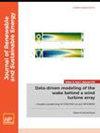Design approach of thrust-matched rotor for basin model tests of floating straight-bladed vertical axis wind turbines
IF 1.9
4区 工程技术
Q4 ENERGY & FUELS
引用次数: 0
Abstract
Rotor redesign approaches have been widely proposed to solve the thrust mismatch issue caused by scaling effects for basin model tests of horizontal axis floating wind turbines (FWTs). However, limited basin model tests utilized the thrust-matched rotor (TMR) to accurately evaluate the aerodynamic loads applying to the vertical axis FWTs. This paper described the detailed design approach of the TMR of floating straight-bladed vertical axis wind turbines (VAWTs) with a rated power of 5.3 MW. First, the AG455 airfoil was selected to replace the NACA0018 airfoil. AG455 airfoil can show a larger lift coefficient and a smaller drag coefficient at low Reynolds number. On this basis, the load distribution match algorithm was used to assign the blade pitch angle and chord length at each section of the blade. This method takes the spanwise load and load change rate of model-scaled blade and full-scaled blade as the constraint conditions. By adopting this method, the rotor thrust can be tailored to match the prototype values across a wide range of tip speed ratios. This design approach proves advantageous in assessing the aerodynamic performance of VAWTs under varying inflow wind speeds and unsteady wind conditions. The redesigned TMR model under low Reynolds number can meet Froude similarity criterion, which is helpful to improve the accuracy of vertical axis FWT model tests in the wave basin.用于浮动直叶垂直轴风力涡轮机海盆模型试验的推力匹配转子设计方法
为解决水平轴浮动风力涡轮机(FWT)海盆模型试验中由缩放效应引起的推力不匹配问题,转子重新设计方法已被广泛提出。然而,利用推力匹配转子(TMR)来准确评估垂直轴浮动风力涡轮机气动载荷的盆地模型试验非常有限。本文介绍了额定功率为 5.3 兆瓦的浮动直叶垂直轴风力涡轮机(VAWT)的推力匹配转子的详细设计方法。首先,选用 AG455 机翼替代 NACA0018 机翼。AG455 机翼在低雷诺数时具有较大的升力系数和较小的阻力系数。在此基础上,采用载荷分布匹配算法分配叶片各段的俯仰角和弦长。该方法以模型比例叶片和全比例叶片的跨距载荷和载荷变化率为约束条件。采用这种方法,转子推力可以在很宽的叶尖速比范围内与原型值相匹配。事实证明,这种设计方法有利于评估 VAWT 在不同流入风速和不稳定风力条件下的气动性能。重新设计的 TMR 模型在低雷诺数条件下能够满足 Froude 相似性准则,有助于提高垂直轴 FWT 模型在波浪盆地测试的精度。
本文章由计算机程序翻译,如有差异,请以英文原文为准。
求助全文
约1分钟内获得全文
求助全文
来源期刊

Journal of Renewable and Sustainable Energy
ENERGY & FUELS-ENERGY & FUELS
CiteScore
4.30
自引率
12.00%
发文量
122
审稿时长
4.2 months
期刊介绍:
The Journal of Renewable and Sustainable Energy (JRSE) is an interdisciplinary, peer-reviewed journal covering all areas of renewable and sustainable energy relevant to the physical science and engineering communities. The interdisciplinary approach of the publication ensures that the editors draw from researchers worldwide in a diverse range of fields.
Topics covered include:
Renewable energy economics and policy
Renewable energy resource assessment
Solar energy: photovoltaics, solar thermal energy, solar energy for fuels
Wind energy: wind farms, rotors and blades, on- and offshore wind conditions, aerodynamics, fluid dynamics
Bioenergy: biofuels, biomass conversion, artificial photosynthesis
Distributed energy generation: rooftop PV, distributed fuel cells, distributed wind, micro-hydrogen power generation
Power distribution & systems modeling: power electronics and controls, smart grid
Energy efficient buildings: smart windows, PV, wind, power management
Energy conversion: flexoelectric, piezoelectric, thermoelectric, other technologies
Energy storage: batteries, supercapacitors, hydrogen storage, other fuels
Fuel cells: proton exchange membrane cells, solid oxide cells, hybrid fuel cells, other
Marine and hydroelectric energy: dams, tides, waves, other
Transportation: alternative vehicle technologies, plug-in technologies, other
Geothermal energy
 求助内容:
求助内容: 应助结果提醒方式:
应助结果提醒方式:


